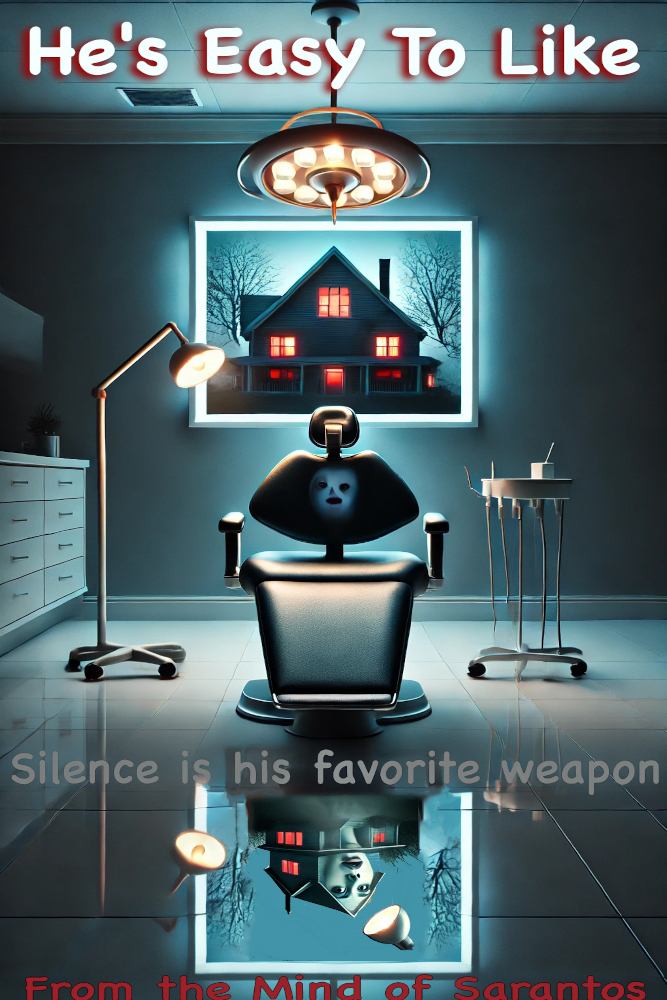
Sarantos Screenplay: He's Easy To Like

Logline:
When a soft-spoken suburban dentist quietly begins eliminating his wife’s cruel, dysfunctional family with clinical precision, the façade of decency fractures—turning his perfect home into a study in control, confession, and the terrifying calm of a man who believes murder is mercy.
Concept
Set in a spotless Midwestern suburb where civility masquerades as virtue, He’s Easy to Like follows a saintly dentist whose weaponized patience becomes a silent cure for a toxic in-law dynasty—and the wife who finally notices that every “accident” in their family feels engineered. As overdoses, strokes, a ladder fall, and a brake failure stack up with surgical precision and a quiet detective begins to hear the pattern in the silence, their marriage curdles into a cat-and-mouse chess match of control versus survival. Blending domestic noir with procedural dread, it’s a chilling, character-driven descent into how kindness can be a scalpel, order can be a cage, and the man everyone trusts can curate grief like a work of art.
Central Theme
The central theme of He’s Easy to Like is control disguised as virtue — the idea that patience, when twisted by trauma and pride, becomes its own form of violence.
It explores how civility can conceal rot, how silence can be both a refuge and a weapon, and how the pursuit of order can mutate into obsession when pain is never spoken aloud. Through Tom’s meticulously composed world — where every death is framed as “correction” — the film examines the illusion of moral superiority and the human need to rewrite suffering into purpose.
At its core, the story asks: When kindness is used to dominate instead of heal, is it still goodness — or just cruelty with better manners?
Plot
When a string of “accidents” claims every member of his wife’s family, mild-mannered dentist Tom Marshall becomes the quiet center of Detective Soto’s investigation — the one man always nearby, always calm, always helping. But inside Tom’s immaculate world of order and symmetry lies a ritual of precision: each death engineered as an act of moral correction. When his wife Cara uncovers his meticulous black notebook, their marriage spirals into a psychological battleground of control, guilt, and survival. As Soto closes in and Tom’s new life with another woman begins to echo the same deadly patterns, the story builds toward one chilling truth — some men don’t lose their patience; they weaponize it. He’s Easy to Like is a taut, slow-burn psychological thriller where civility becomes camouflage and silence kills louder than screams.
Genre: Psychological Thriller
Subgenres:
- Domestic Noir / Suburban Horror
- Character-Driven Crime Drama
- Psychological Cat-and-Mouse
- Moral Descent / Intimate Villain Study
Why This Fits:
- Tone: Cold, deliberate, and unnervingly quiet—a slow burn where tension simmers beneath civility until it explodes in stillness rather than spectacle.
- Structure: Follows a classical psychological thriller arc—false calm in Act I, escalating unease in Act II, and intimate confrontation in Act III. The suspense isn’t built on chase scenes or gore, but on dread, restraint, and emotional precision.
- Characters: A protagonist who blurs the line between victim and predator, a wife who becomes both detective and target, and an investigator who represents conscience in a story without heroes.
- Themes: Moral corruption hidden inside domestic perfection, control masquerading as kindness, and the horror of realizing that evil can look—and sound—like love.
In Studio Terms:
If you pitched it to studios or streaming platforms, you would call it:
"A slow-burn Psychological Thriller in the spirit of Gone Girl meets American Psycho."
Or simply:
"An unnerving domestic thriller about the quietest monster imaginable."
Synopsis
Tom Marshall is the kind of man everyone trusts. A mild-mannered suburban dentist, devoted husband, and church volunteer, he’s the quiet center of a seemingly perfect Midwestern life. His patients adore him. His in-laws mock him. And his wife, Cara, barely looks at him anymore. Behind the smile and calm tone, something inside Tom has been quietly cracking—an ache no one sees and no one cares to fix.
When Cara’s arrogant brother steals from their son and the family closes ranks to defend him, Tom’s last thread of restraint snaps. His first act of revenge—clean, clinical, undetectable—feels like peace. Soon, tragedy after tragedy strikes Cara’s family: a mother’s sudden heart attack, a sister’s car crash, a father’s fatal toast. The police call them accidents. Tom calls them “corrections.” Each death is as methodical as one of his dental procedures—precise, painless, and justified.
Detective Soto, a weary investigator with a gift for reading quiet men, begins to suspect that Tom’s calm hides something sinister. But the evidence is too perfect, the story too clean. As Soto digs deeper, Cara starts piecing together the truth herself. A hidden notebook, strange purchases, subtle confessions—all point to a husband who’s been conducting his own moral experiment.
What follows is a psychological chess match between a killer who believes he’s cleansing the world and a wife who realizes she’s next on his list. Their marriage becomes a battlefield of politeness and paranoia, every dinner a silent test of survival. When Tom finally offers Cara a cup of tea, she knows it’s the last choice she’ll ever make, and drinks it anyway.
By morning, Cara is gone. The house is spotless. Tom sits on the porch with a cup of tea, serene as ever, while Detective Soto watches helplessly, unable to prove a thing. Months later, Tom has remarried into another wealthy, dysfunctional family. The smiles, the charm, the civility—it’s all back in place. But this time, when he looks into the camera and says, “I love it when they’re mean to me,” we understand: monsters don’t roar. They whisper, they smile, and they wait to be invited back in.
A chilling portrait of charm, control, and quiet malevolence, He’s Easy To Like is a psychological thriller about the horror of politeness—and how evil can hide behind the gentlest face in the room.
Comps
Comp #1 (Two Films):
It’s Gone Girl meets The Gift.
A slow-burn psychological thriller that weaponizes domestic normalcy — exploring how politeness, manipulation, and control become as lethal as violence itself. Like Gone Girl, it dissects a marriage from the inside out, and like The Gift, it traps the audience in intimate, unnerving stillness where every smile hides a threat.
Comp #2 (Film + Genre Element):
It’s American Psycho with the intimacy of a Marriage Story.
A chilling study of charm, civility, and quiet sociopathy, told through a claustrophobic domestic lens. The horror doesn’t come from brutality, but from composure — a killer who hides behind the rituals of kindness, love, and order.
Comp #3 (Streaming-Friendly Framing):
It’s You (Netflix) reimagined as a prestige character study.
Designed for audiences drawn to morally complex antiheroes and meticulously crafted tension, He’s Easy To Like delivers the sophistication of a festival thriller with the binge-worthy pull of high-end streaming drama.
Elevator Pitch:
He’s the man everyone trusts — the quiet dentist with the perfect smile, the steady hands, the kind eyes. But behind Tom Marshall’s calm facade is a meticulous predator who believes murder is mercy and forgiveness is just another form of control.
When his wife’s cruel, manipulative family begins dying one by one, what looks like tragedy becomes a study in perfection — and as Detective Soto closes in and Cara realizes she’s the final name in her husband’s ledger, the walls of their suburban home turn into a psychological pressure cooker.
He’s Easy to Like is a slow-burn psychological thriller about the monster who hides behind good manners — a chilling, character-driven descent into obsession and silence.
Think Gone Girl meets The Gift, with the intimate dread of You and the moral chill of American Psycho.
Character Conflict:
Character Conflict:
Character Conflict Summary:
Tom vs. Cara
Tom’s Core Conflict:
He’s calm, meticulous, and pathologically polite — a man who’s learned to survive through control. Tom’s entire identity is built on restraint, order, and being “the good man.” But underneath that composure lies a lifetime of humiliation, quiet rage, and the belief that his decency has made him invisible.
- Wound: Years of emotional belittlement from his wife’s family, coupled with a cold, domineering father who equated weakness with failure.
- Flaw: Mistakes control for virtue — believes emotional suppression equals moral strength.
- Fear: Losing control will expose the monster he’s always feared he might be.
Cara’s Core Conflict:
She’s intelligent, lonely, and defensive — a woman who’s built sarcasm into armor. Trapped in a marriage that feels more like observation than love, Cara numbs her unease with routine and denial. Her guilt and self-preservation collide when she begins to suspect her husband is orchestrating tragedy in their lives.
- Wound: Years of emotional neglect and gaslighting have made her distrust both affection and her own instincts.
- Flaw: Confuses detachment with safety — believes feeling less will protect her.
- Fear: That she enabled the darkness now consuming her home, and that she might deserve it.
Where They Collide:
Their marriage becomes a psychological battleground between control and truth. Tom demands silence and obedience disguised as calm, while Cara begins clawing for the reality beneath his civility. He sees her suspicion as betrayal; she sees his politeness as a mask for horror. Their interactions, once empty, turn into a cold war of manners where every word has weight and every silence could mean survival.
Central Emotional Conflict:
Can a marriage built on appearances withstand the revelation that its foundation is murder — or will one partner’s pursuit of truth destroy them both?
Bonus Conflict Dynamics:
- They mirror each other’s repression — his through control, hers through avoidance.
- He craves validation for his suffering; she craves acknowledgment of her fear.
- Their power dynamic flips as Cara transitions from passive spouse to active survivor, while Tom’s “order” unravels into obsession.
Why This Conflict Is Strong:
- It’s intimate and psychological — the violence is emotional long before it’s physical.
- It’s philosophical — one believes morality lies in precision, the other in conscience.
- It’s relentlessly cinematic — their quiet domestic spaces become the stage for terror, confession, and self-destruction.
One-Line Character Conflict Summary:
A husband obsessed with control and a wife desperate for truth spiral into a deadly power struggle where love, guilt, and survival are indistinguishable.
Character Info:
Tailored specifically for industry listings like screenplay databases, pitch portals, or competitions.
Character Profiles:
- Tom Marshall
Lead – Male, 40s–50s. Controlled. Charming. Unsettling.
Description: Tom is a suburban dentist whose quiet demeanor and polite smile mask a deeply fractured psyche. A perfectionist in every aspect of his life — from his sterile clinic to his meticulously organized garage — Tom believes control is the only cure for chaos. His measured voice, courteous manners, and calm gaze make him the kind of man people trust instantly… and that’s his greatest weapon. Beneath his civility lives a methodical killer who sees murder as mercy — the final form of order.
Character Type: Soft-spoken antagonist and unreliable protagonist — a portrait of moral decay hidden inside gentleness.
Think: Michael C. Hall in Dexter meets Jake Gyllenhaal in Nightcrawler.
Arc: Tom begins as a victim of emotional abuse and quiet humiliation, presenting himself as the embodiment of patience. As the story unfolds, his composure transforms into justification, and his “forgiveness” becomes a system of execution. By the end, he has achieved perfect stillness — not redemption, but peace through delusion.
Casting Notes: Requires an actor with extreme subtlety — someone who can shift from empathy to menace with a single glance.
- Cara Marshall
Lead – Female, late 30s–40s. Intelligent. Guarded. Fragile beneath the surface.
Description: Cara is Tom’s wife — a woman who once craved stability but has slowly realized she built her life inside a cage of politeness. Once warm and witty, she’s become brittle, her laughter forced, her silences heavy. She suspects something is wrong long before she dares to name it. Her internal conflict lies between denial and survival: the terrifying knowledge that the man who once protected her now studies her like prey.
Character Type: Emotionally complex female lead — both victim and challenger in a domestic psychological battle.
Think: Rosamund Pike in Gone Girl meets Naomi Watts in The Impossible (psychological intensity, not genre tone).
Arc: Cara begins as passive, numbed by years of manipulation and dismissal. As the truth unravels, she finds her voice and courage, reclaiming her agency even as it costs her everything. Her arc transforms quiet fear into defiant self-recognition — a tragic awakening.
Casting Notes: Ideal for an actress who can play nuance — someone whose eyes reveal intelligence, dread, and flickers of rebellion beneath fear.
- Detective David Soto
Supporting – Male, 40s–50s. Analytical. Tired. Moral center.
Description: Detective Soto is the quiet conscience of the film — a methodical investigator with a skeptic’s patience and a priest’s empathy. A man who’s seen too many monsters hiding in plain sight, he doesn’t mistake politeness for innocence. His pursuit of Tom isn’t driven by glory but by moral duty, even when the evidence refuses to cooperate.
Character Type: Stoic investigator — grounded, human, a truth-seeker caught in a web of subtle evil.
Think: Oscar Isaac in Inside Llewyn Davis meets Morgan Freeman in Se7en.
Arc: Soto’s journey is one of frustration and futility. He finds the truth but can’t prove it, becoming the only person who truly sees Tom for what he is — and must live knowing justice slipped through his fingers.
Casting Notes: Requires quiet intensity; best suited for an actor with gravitas and empathy beneath fatigue.
- Victoria Hale-Marshall
Supporting – Female, 40s. Elegant. Calculated. Social predator.
Description: Tom’s new wife in the epilogue — confident, wealthy, and drawn to dominance disguised as charm. She represents the next cycle of Tom’s pathology: a woman who mistakes composure for safety and control for care. Though she believes she’s chosen wisely, she’s unknowingly stepped into a new experiment.
Character Type: Glamorous supporting role — symbol of repetition and delusion.
Think: Nicole Kidman in The Others meets Cate Blanchett in Tár.
Arc: Victoria doesn’t evolve so much as repeat history — a mirror held up to Cara, and to every person who’s ever mistaken danger for devotion.
Casting Notes: Ideal for an actress with commanding elegance and quiet arrogance — someone who exudes power but doesn’t see the trap closing around her.
Budget:
Low-to-mid budget range for a contained psychological thriller or prestige domestic noir.
Estimated Budget Category: $3M–$8M USD
This positions it alongside other elevated, character-driven thrillers that rely on performance, tone, and atmosphere rather than scale or effects.
Why this Budget Range Works:
Primary Costs:
- Cast: Two primary leads (Tom and Cara), one strong supporting investigator (Detective Soto), and 4–5 secondary roles (family members, minor characters).
- Location: Single primary house setting (Marshall home), one clinic interior, police station, and a few exteriors—suburban streets, church, and wedding hall.
- 70–80% of the film takes place indoors, allowing for controlled, efficient shooting.
- Production Design: Focused on creating visual contrast between sterile perfection and creeping unease—achievable through lighting, art direction, and sound rather than elaborate sets.
- Effects: Minimal practical effects (a few staged deaths, minor makeup, prop manipulation). No CGI or large stunt coordination.
Production Style:
- Highly contained, dialogue-driven, and performance-based—ideal for a 25–30 day shoot.
- Psychological tension replaces traditional action; most suspense comes from pacing, sound design, and framing.
- Limited company moves and a small core crew keep costs lean while maintaining visual polish.
Comparable Projects:
- The Gift (Blumhouse / STX – est. ~$5M)
- Gone Girl (scaled-down structure comparison; similar tonal aim on an indie scale)
- You Should Have Left (Universal / Blumhouse – est. ~$7M)
- Watcher (IFC / Chloe Okuno – est. ~$4M)
Special Studio Note:
If produced through an indie or boutique label with a strong visual director and two recognizable leads, He’s Easy To Likecould deliver high tension and awards-level performances on a lean, commercially viable budget—an ideal “prestige thriller” for festival competition and streamer acquisition.
Pitch Sheet:
Project Title: He’s Easy To Like
Genre: Psychological Thriller
Subgenres: Domestic Noir · Character-Driven Crime Drama · Intimate Psychological Horror
Tagline: He doesn’t raise his voice. He just removes the noise.
Elevator Pitch:
It’s Gone Girl meets The Gift — a chilling, slow-burn thriller about a suburban dentist whose calm perfection hides a meticulous killer. When his wife’s cruel family begins dying one by one, the façade of civility collapses into a psychological war between appearances, morality, and survival. By the time his wife realizes she’s the final name in his ledger, the only thing deadlier than his methods is his composure.
Tone & Vibe:
Gone Girl meets You, with the moral unease of American Psycho and the emotional tension of Marriage Story. Elegant, restrained, and unnervingly quiet — a thriller where dread builds in whispers, not screams. Every frame feels like a secret someone is too polite to tell.
Logline:
When a soft-spoken dentist begins methodically “cleansing” his wife’s toxic family, the crimes appear accidental — until his wife discovers his notebook and realizes she’s next. What follows is a battle of silence and survival between two people trapped in the polite hell of a perfect marriage.
Key Selling Points:
- High-concept domestic thriller with festival-level sophistication and streaming appeal.
- Character-driven tension built around manners, psychology, and moral decay — not gore.
- Contained locations — a single suburban home becomes a pressure cooker of civility and horror.
- Unreliable protagonist invites comparisons to Gone Girl, You, and Nightcrawler.
- Minimal effects, low-cost production potential, and awards-caliber acting showcase.
Primary Audience:
Fans of Gone Girl, You, The Gift, The Invitation, and American Psycho.
Ideal for Netflix, Hulu, Amazon Prime, or Apple TV+ — platforms drawn to slow-burn, prestige thrillers with binge potential and word-of-mouth power.
Market Positioning:
A prestige, festival-ready psychological thriller with mainstream streaming appeal. Designed for distributors seeking elegant, character-driven suspense with franchise potential in the “quiet monster” subgenre of domestic horror. Perfect for audiences who crave morally complex villains and intelligent, atmospheric tension.
Budget Category:
Low-to-mid budget ($3M–$8M). Primarily one location, few characters, high emotional and cinematic return on investment.
Lead Characters:
Tom Marshall – 40s–50s
A calm, meticulous dentist whose charm hides a void. Years of humiliation have shaped him into a man who sees control as morality — and murder as purification.
Type: Controlled, intelligent, soft-spoken sociopath.
Arc: Transforms from invisible husband to self-anointed moral arbiter, losing his humanity under the guise of righteousness.
Cara Marshall – 30s–40s
Tom’s wife — elegant, intuitive, and trapped in denial. Years of emotional erosion have left her numb, until she begins to suspect her husband’s calm is something far more dangerous.
Type: Intelligent, brittle, emotionally starved woman finding courage through terror.
Arc: Evolves from passive victim to active survivor, reclaiming power through awareness — though too late to escape it.
Themes:
- The illusion of control and the violence hidden in civility.
- Marriage as both sanctuary and prison.
- The thin line between moral order and monstrous obsession.
- Evil disguised as decency — the scariest kind.
Why It Works for Big Studios or Streamers:
- Elevated, character-driven thriller with high psychological and moral tension.
- Star vehicle potential — one major male and one female lead with awards-level emotional range.
- Low production cost, high stylistic return — tailor-made for premium streaming or festival acquisition.
- Market-tested genre: domestic thrillers remain top-performing for both theatrical and streaming audiences.
- Builds audience obsession through restraint, tension, and moral ambiguity — perfect for post-Gone Girl and You audiences seeking their next fixation.
Script:
This document is view-only for content protection.
If you’d like a personal copy to read, please email me at info@melogia.com
Follow Sarantos:
- Website: www.melogia.com
- Amazon: Sarantos on Amazon
- Author’s Guild: Author’s Guild
- BookBaby: Sarantos on BookBaby
- YouTube: SarantosMelogia
- Goodreads: Sarantos on Goodreads
- Facebook: @SarantosMelogia
- Instagram: @SarantosMelogia
- Twitter: @SarantosMelogia
- TikTok: @Sarantos




















